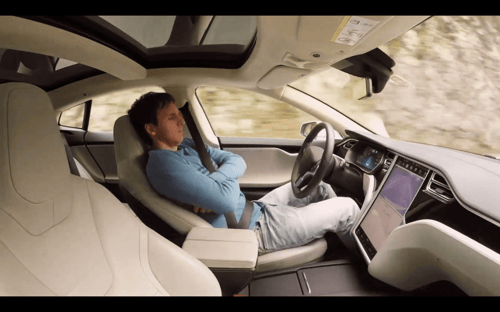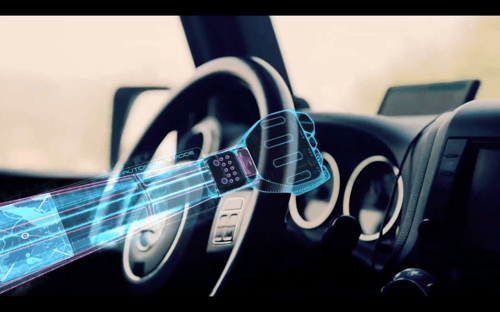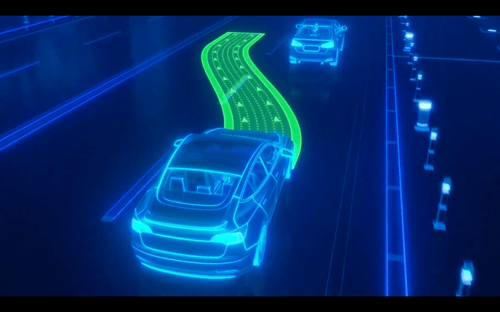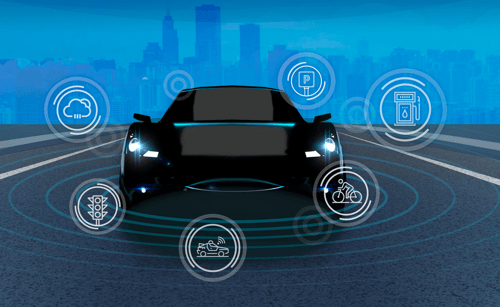5G: The Smart City of Things
You are entering....The Smart City of Things. How 5G is making the previously impossible possible in real-time data collection. Intertraffic talks to experts from the UK, Germany, Belgium and the US to discuss its benefits and potential impact.
“What does 5G mean in terms of outcomes and effects for smart cities and smart mobility?” asks Bob McQueen, founder of Bob McQueen & Associates, an Orlando, Florida-based smart city and ITS consultancy. “Before we go any further we really need to establish that.”
After nearly 40 years in the transport sector McQueen has “seen it, done it and bought the t-shirt” and the development of 5G, and in particular its potential to enhance the way that data is collected in the smart city, is a topic he’s only too willing to expound (and expand) upon.
“5G will be green,” he begins. “People in urban areas consume about 75% of the earth’s natural resources and we can apply 5G for management and control of water, energy, and transportation to make better use of these resources in terms of efficiency and productivity. I am defining efficiency as the difference between what goes in and what comes out of the system and productivity as the amount of value that can be delivered within a given time. I expect 5G to make both of these measures better.”
Put simply, 5G communications will move data from you to somewhere else and back again a whole lot quicker than it ever could before, but how will this benefit society?
“Well it depends on how you use the time you’re going to save!” McQueen retorts. “When we’re developing smart mobility plans for smart cities we often look at the total amount of time that could be saved by shorter trips and more reliable travel. Maybe it’s just the way I think, but I often wonder if we develop a new system that will save people five hours per week, what they will do with that extra time, will it be of benefit to society? Perhaps this is too judgmental and maybe the benefit is just the people have more time available to decide what to do.”
Eric Masaba, founder of ride-sharing platform Texxi and developer of the RoadSpaceTime concept, believes that 5G is a major step forward in communication integration.
“The evolution of 5G promises so much more beyond simple data transfer or range increases. The ability to integrate 5G devices with wi-fi, mesh networks and radio frequencies offer for the first time a seamless experience making mobile devices, whether embedded in vehicles, remote sensors or handsets as connected to the global Internet as any device is to home broadband,” he explains.
“Another huge benefit is the tradeoffs inherent in other technologies that existed before between power consumption, data transfer and range can be mitigated or even eliminated with seamless 5G integration. It is now possible, for example, for a taxi service in a remote area of Pakistan or Tanzania to have a completely mesh-based network centred on the vehicles themselves as nodes passing communications between the vehicles in a peer-to-peer network, while still being able to communicate with a base station while any one of the nodes is in range. This base station, connected to a Wide Area Network then provides Internet connectivity to all the nodes. Without 5G, this would not be possible.”
Supporting the Business Community
In terms of 5G development and implementation, two of the leading regions in Europe are in the UK. Chris Holmes, Programme Director of Transport at West Midlands 5G (WM5G), the UK’s first region-wide 5G testbed, backed by Department for Digital, Culture, Media and Sport and West Midlands Combined Authority (the other member of the top two is the City of Sunderland), says 5G can help revolutionise the region’s transport systems, which could prove vital to its growth and financial recovery post COVID-19.

“Even before the pandemic, WM5G was committed to accelerating mobile and super-fast fibre broadband connectivity in the West Midlands in the hope of making it the best-connected region in the country. Although we have some distance to go before realising 5G or superfast connectivity for all, we must continue to support our local authorities. This will ensure resilient connectivity for now and for years to come by taking the necessary steps to create a better-connected future.”
WM5G’s recent trial with Intertraffic Webinar participants AppyWay illustrated how 5G can reduce the time it takes to find a parking space. With on-street parking a rare commodity and an average of 7 minutes is spent in search of spaces in an urban setting, a solution was needed.

5G’s low latency allowed AppyWay to process high volumes of vehicle-mounted camera data in real-time, analysing high-resolution video footage with AI adding to the data sources available to provide a wide geographical coverage of parking spaces. The aggregated data will alert drivers to parking availability instantaneously through an app, making journeys quicker, improving traffic flow and reducing emissions.
The West Midlands is a veritable hotbed of transport innovation with many R&D projects currently in progress with Transport for West Midlands (TfWM) taking an active role.

“WM5G’s Transport programme consists of a portfolio of projects which have been developed to support new 5G-enabled products and services. The outcome of these trials will make a significant difference to transport across the West Midlands region and have national relevance,” explains Holmes who will be one of the speakers at the next Intertraffic Webinar on Tuesday 24 November.
Global growth with Mobility as a Service and connected vehicles
As for exactly will 5G stimulate global growth, rather than regional in the case of the West Midlands, Bob McQueen is convinced that even while we continue to deal with the widespread effects of Covid-19, 5G will allow us to continue to collaborate and communicate while social distancing.
“The incredible rise in the use of Zoom meeting, GoToMeeting, Teams and WebEx is testament to this. However, I believe that even in normal times 5G will stimulate global growth. In many cases, 5G will act as an enabler providing infrastructure support for other services that deliver direct benefit. Things that come to mind include Mobility as a Service and connected vehicles. 5G will also support global growth as new products and services are developed for the Internet of Things. This means that the Internet will go beyond connecting people together to connecting devices and even domestic appliances. Your refrigerator can be sensorized and connected to the Internet to make sure you don’t run out of any particular food,” he digresses. “It could also be linked to your doctor’s office to make sure that you only buy healthy food. Imagine trying to open your fridge door at 10pm for a late-night snack to be informed that this is not good for you and the fridge door will not open. Or even worse, the fridge sends an alarm to your doctor’s office and set up an appointment first thing in the morning.”
Driving a Revolution since 4G
Talking of connected vehicles, Maxime Flament, Chief Technology Officer of the 5G Automotive Association (5GAA), sees 5G-enabled C-V2X (Cellular Vehicle to Everything) as the ideal solution to bridge the gap between short- and long-range communications.
“Since 4G invaded our daily lives around 2010, there has been a common trend to connect everything that is around us. Oddly, vehicle connectivity did not evolve as fast as other markets, like consumer electronics, logistics, and so on, but it is clear that an adjustment is coming very fast,” warns Flament. “New electronic architecture and electric powertrain make it even easier to make it happen. So we should expect a wave of connected cars in the couple next years on our showrooms.”

If your next question is ‘what are the types of use cases are strongly enabled with 5G?’, Flament has a comprehensive answer.
“One of the recurring answers is Tele-operation. It sounds like an easy one but the ramification of Tele-operation may be much broader than previously foreseen. First this Tele-operation can be done in many different steps: Monitoring of an autonomous vehicle (AV) fleet, guidance of AV in corner cases, and finally the takeover of the complete driving task.
“The great thing is that we do not have to wait for fully automated vehicles. There are some essential features required, such as sensors, actuators and a guaranteed radio link. For the sensors and actuators, current automation in vehicles may already have a good basis for Tele-operation. In fact, large fleets of vehicles are already Tele-operated in mines, harbours and with light rail; all of them are relying on a reliable radio link. That’s where 5G comes with a guaranteed quality of service on a mainstream mobile network. The combination may prove very appreciated even before full Level 4 autonomous vehicles start to appear on our roads. The typical user-centric applications are countless both for AV and non-AVs.”

Grabbing Attention
The ability to communicate faster and use more data will also inevitably mean more commercials and advertising. It can also mean more sophisticated approaches to advertising with the use of holograms, augmented reality and virtual reality. As Bob McQueen elucidates, 5G has a starring role to play here, too.
“The ability for 5G to support attention grabbing is also good in terms of travel information and other information that will help to improve your decision-making. As our world continues to be connected with faster and faster communications and more and more data, it will also be necessary to absorb and actually do something with that data. Personally, I would like a 5G-supported application that will read everything online, paper, social media and every channel on my behalf and then tap me on the shoulder when something is of interest or value to me. Of course, if that something happens to be a threat, then I would like to receive the advisory sooner rather than later. Perhaps this could be a premium service, supported by advertising?”
GDPR: Remaining Private
This concept, however, bring us nicely into the bear-pit of privacy. The irony of Facebook posts complaining that Coronavirus track and trace apps are an invasion of privacy aside, how much data should genuinely be shared?
Maxime Flament believes it’s a subject that has been ignored for many years as a possible show-stopper, especially for short range communication. “The fact is that short-range communication in its current broadcasting mode did not take privacy considerations into account. The stringent General Data Protection Regulations (GDPR) are really challenging; discussions on this topic have been held ad nauseam without finding a real solution. There is no doubt broadcasted CAMs are useful for many purposes but it does not justify all vehicles broadcasting their speed, position and direction 10 times a second. Such privacy issues will eventually hurt the adoption of short-range communication mode,” he explains.
“My logical approach would be to bet on services with great perceived added-value which convince a sufficient amount of drivers to accept to broadcast their safety information. The same discussions are less applicable when talking about the 4G/5G mobile network connectivity. Stringent privacy rules apply to all forms of communication. In cases where vehicle information is gathered in a vehicle back-end, a contractual relationship will exist, the data controller is well-known and bears its responsibility with regards to the GDPR.”
Being for the Benefit of Everyone: 5G and V2V
Marcel Visser, founder of MV Powered Ingenuity and formerly with Gemalto and the ERTICO Supervisory Board, believes that the benefits of 5G in the context of smart mobility are only just being fully understood and realised.
“The benefits of 5G for V2V communications are huge, but let’s start with there is no need to get connected to a mobile communication network. 5G for V2V allows for the discovery of thousands vehicles via protocols that enable that discovery to happen completely autonomously. Crucially, it doesn’t drain the in-vehicle unit’s power resources compared to units connected to a mobile network.”
In addition, Visser says that V2V communications have been shown to enable or enhance a number of demonstrated applications like platooning or electronic tolling, but it’s with reference to more day-to-day advanced driver assistance systems that 5G can make or more easily marketable impact.
“With 5G Information sharing is performed at high speeds without significant latency and this in turns opens the door, figuratively, for:
- Safety applications;
- Messaging, forward collision warnings, emergency braking warning for slippery roads, etc;
- A safer end-user driving experience, for example increasing ad hoc awareness providing actual information about a vehicles‘ environment and current situation.”
Visser concludes with a note of caution. “However, in V2V safety communications, for widespread acceptance of a mandated V2V safety system it’s absolutely crucial that the users can rely on the authenticity and integrity of the received messages. A message should contain no information that directly identifies the driver, the passengers or the vehicle and it should be difficult, or virtually impossible for, let’s call them an eavesdropper, to track a driver or vehicle by recording its messages.”
Eric Masaba sums up the gathering pace of the 5G (r)evolution, maintaining that it is vitally important, especially for blockchain applications, “where nodes have to be in contact some part of every hour, but not necessarily all the time. This helps preserve the power consumption of small devices, while allowing for remote sensor updates.
“To do this currently requires a ‘hotch-potch’ of technologies, but 5G will simplify and streamline everything. The ability for small devices to connect even to satellite networks is promised. 5G is, quite simply, a game-changer.”
Share your story
Do you have an innovation, research results or an other interesting topic you would like to share with the professionals in the infrastructure, traffic management, safety, smart mobility and parking industry? The Intertraffic website and social media channels are a great platform to showcase your stories!
Please contact our Sr Brand Marketing Manager Carola Jansen-Young.
Are you an Intertraffic exhibitor?
Make sure you add your latest press releases to your Company Profile in the Exhibitor Portal for free exposure.
Get up to speed on the mobility industry - our newsletter straight to your inbox!



